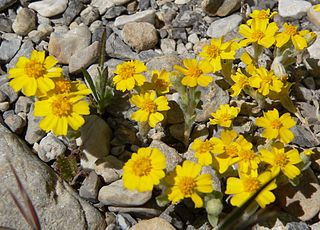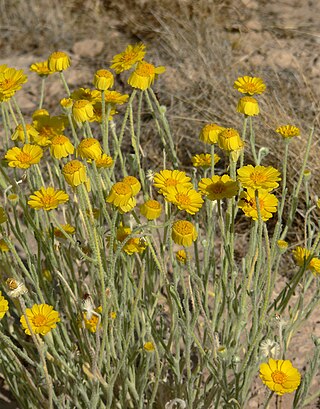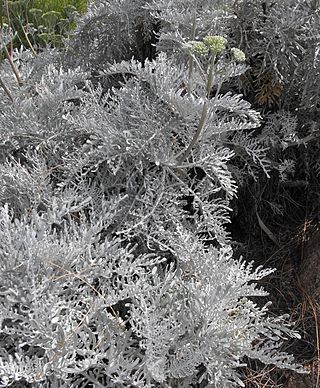
Eriophyllum lanatum, with the common names common woolly sunflower, Oregon sunshine and golden yarrow, is a common, widespread, North American plant in the family Asteraceae.

Eriophyllum lanosum, the white woolly daisy or white easterbonnets, is a spring wildflower in the family Asteraceae. It grows in the eastern Mojave Desert and the Sonoran Desert in the southwestern United States and northwestern Mexico.
Eriophyllum latilobum, the San Mateo woolly sunflower, is a perennial herb of sharply limited range, endemic and occurring only in the state of California, United States. This flowering plant of the family Asteraceae has been listed as an endangered species by the U.S. federal government as well as the state of California.

Eriophyllum wallacei is a North American flowering plant in the family Asteraceae known by the common names woolly daisy and woolly easterbonnets. It grows in the southwestern United States and northwestern Mexico. It may grow in clumps or on short erect stems in sand, rocks, and gravel.

Eriophyllum multicaule is a North American flowering plant in the family Asteraceae, known by the common name manystem woolly sunflower. It is native to California and Arizona in the southwestern United States.

Eriophyllum staechadifolium is a flowering plant in the family Asteraceae which is known by the common name seaside woolly sunflower. It is native to the coastline of Oregon and California including the Channel Islands. This is a plant of the beaches, dunes, and coastal scrub.

Helianthella californica is a species of flowering plant in the family Asteraceae known by the common name California helianthella. This wildflower is native to the mountains of California, northwestern Nevada, and southwestern Oregon.

Helianthus bolanderi is a species of sunflower known by the common names Bolander's sunflower and serpentine sunflower. It is native to California and Oregon, where it grows mainly in mountainous areas, often in serpentine soils. It has been found from southwestern Oregon as well as in northern and central California as far south as Santa Cruz County, with reports of a few isolated populations in southern California.

Helianthus exilis is a species of sunflower known by the common name serpentine sunflower. It is endemic to northern California, where it grows mainly in mountainous areas, often in serpentine soils.

Helianthus gracilentus is a species of sunflower known by the common name slender sunflower. It is native to central and southern California and Baja California, where it is a member of the dry wildfire-prone chaparral ecosystem.
Hulsea californica is a rare species of flowering plant in the family Asteraceae known by the common names San Diego alpinegold and San Diego sunflower. It is endemic to southern California, where it grows only in the Peninsular Ranges.
Hulsea nana is a North American species of flowering plant in the family Asteraceae known by the common name dwarf alpinegold. It is native to the western United States from Washington, Oregon, and far northern California.

Baileya pleniradiata is a North American species of flowering plant in the daisy family, known by the common name woolly desert marigold. It is native to desert regions of the southwestern United States and northern Mexico, where it grows in sandy habitats. It has been found in the States of Chihuahua, Sonora, Baja California, Arizona, Utah, and Nevada.

Eriophyllum mohavense, also known as the Mojave woolly sunflower or the Barstow woolly sunflower, is a rare species of small annual flowering plant in the family Asteraceae, found only (endemic) in the Mojave Desert of California.
Eriophyllum ambiguum is a species of flowering plant in the family Asteraceae known by the common name beautiful woolly sunflower. It is native to the deserts and adjacent hills of southern and eastern California, northwestern Arizona, and southern Nevada.
Eriophyllum congdonii, known by the common name Congdon's woolly sunflower, is a rare California species of flowering plant in the family Asteraceae.
Eriophyllum jepsonii is a rare North American species of flowering plant in the family Asteraceae known by the common name Jepson's woolly sunflower. It is endemic to California, where it has been found in the Central Coast Ranges and adjacent hills from Contra Costa County to Ventura County.

Constancea is a monotypic genus of flowering plants in the family Asteraceae containing the single species Constancea nevinii, which is known by the common name Nevin's woolly sunflower. It is endemic to three of the Channel Islands of California, where it grows in coastal scrub habitat. This is a small shrub or subshrub generally growing up to one or 1.5 meters tall, and taller when an erect form, with a branching, woolly stem. The whitish, woolly oval leaves may be up to 20 centimeters long and are divided into many narrow lobes with edges curled under. The inflorescence is a cluster of 10 to 50 or more small flower heads, each on a short peduncle. The flower head has a center of hairy, glandular, star-shaped yellow disc florets and a fringe of four to nine yellow ray florets, each about 2 millimeters long. The fruit is an achene a few millimeters long with a small pappus at the tip.

Eriophyllum pringlei is a North American species of flowering plant in the family Asteraceae known by the common name Pringle's woolly sunflower. It is native to the southwestern United States and northern Mexico, where it grows in several types of desert, canyon, and hillside habitat, such as chaparral and sagebrush.
Jensia yosemitana is a species of flowering plant in the family Asteraceae known by the common name Yosemite tarweed. It is endemic to California, where it has a scattered distribution across the Sierra Nevada and its foothills. Some of the populations lie inside Yosemite National Park.














